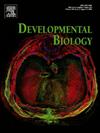Exploring the differentiation potential of EomesPOS mouse trophoblast cells in mid-gestation
IF 2.5
3区 生物学
Q2 DEVELOPMENTAL BIOLOGY
引用次数: 0
Abstract
Mouse trophoblast stem (mTS) cells can be derived from the blastocyst or extraembryonic ectoderm as late as embryonic day (E) 6.5 and when cultured in vitro, can differentiate to all trophoblast subtypes of the mature placenta. Expression of the T-box transcription factor, Eomes, is required for the maintenance of, and used to identify mTS cells. During development, Eomes is restricted to the ExE and, by E7.5, to the chorion, after which its expression declines. The placental junctional zone and labyrinth layers are thought to develop exclusively from the ectoplacental cone and chorion, respectively. While it is well established that mTS cells express Eomes in vitro, it is unknown if Eomes-positive (EomesPOS) trophoblast that reside in the chorion after E6.5 are restricted in their developmental potential to the labyrinth layer in vivo. This study utilized a lineage tracing technique to evaluate the in vivo differentiation of EomesPOS trophoblast. Using an Ai6 reporter mouse crossed with a tamoxifen-inducible Eomes-Cre-ERT2 mouse, Cre was activated from E7.5 to E9.5, permanently marking all EomesPOS trophoblast and daughter cells with the ZsGreen fluorescent protein. This approach was complemented with immunofluorescence staining to assess how the EomesPOS trophoblast had contributed to the differentiated trophoblast population within the placenta by E17.5. Importantly, the results show that daughter cells of EomesPOS trophoblast in which Cre was activated, contributed to both placental layers; specifically, spongiotrophoblast and glycogen trophoblast within the junctional zone and syncytiotrophoblast and sinusoidal trophoblast giant cells within the labyrinth. This confirms that EomesPOS trophoblast maintain the capacity to contribute to both placental layers in vivo and do so after E7.5. This study expands our understanding of trophoblast differentiation in vivo and may prove useful in assessing how EomesPOS trophoblast contribute placental development later in gestation and in the context of placental pathology, where Eomes expression has been reported.

妊娠中期EomesPOS小鼠滋养细胞分化潜能的探讨。
小鼠滋养细胞干细胞(mTS)可以在胚胎日(E) 6.5时从囊胚或胚外胚层中获得,在体外培养时,可以分化为成熟胎盘的所有滋养细胞亚型。T-box转录因子Eomes的表达是维持mTS细胞所需的,并用于鉴定mTS细胞。在发育过程中,Eomes局限于ExE,到E7.5时,则局限于绒毛膜,此后其表达下降。胎盘连接带和迷宫层被认为分别完全由胎盘外锥体和绒毛膜发育而来。虽然已经确定mTS细胞在体外表达Eomes,但尚不清楚Eomes阳性(EomesPOS)滋养细胞在E6.5后存在于绒毛膜中,其体内发育潜力是否限制在迷宫层。本研究利用谱系追踪技术评价EomesPOS滋养细胞的体内分化。使用Ai6报告小鼠与他莫昔芬诱导的Eomes-Cre-ERT2小鼠杂交,将Cre从E7.5激活到E9.5,用ZsGreen荧光蛋白永久标记所有EomesPOS滋养细胞和子细胞。该方法与免疫荧光染色相补充,以评估EomesPOS滋养细胞如何促进E17.5胎盘内分化的滋养细胞群体。重要的是,结果表明,Cre被激活的EomesPOS滋养细胞的子细胞对两个胎盘层都有贡献;具体来说,海绵状滋养细胞和糖原滋养细胞位于交界区,合胞滋养细胞和窦状滋养细胞巨细胞位于迷宫区。这证实了EomesPOS滋养细胞在体内以及在E7.5之后保持了形成两层胎盘的能力。这项研究扩大了我们对滋养细胞在体内分化的理解,并可能有助于评估EomesPOS滋养细胞如何在妊娠后期促进胎盘发育,以及在胎盘病理的背景下,Eomes表达已被报道。
本文章由计算机程序翻译,如有差异,请以英文原文为准。
求助全文
约1分钟内获得全文
求助全文
来源期刊

Developmental biology
生物-发育生物学
CiteScore
5.30
自引率
3.70%
发文量
182
审稿时长
1.5 months
期刊介绍:
Developmental Biology (DB) publishes original research on mechanisms of development, differentiation, and growth in animals and plants at the molecular, cellular, genetic and evolutionary levels. Areas of particular emphasis include transcriptional control mechanisms, embryonic patterning, cell-cell interactions, growth factors and signal transduction, and regulatory hierarchies in developing plants and animals.
 求助内容:
求助内容: 应助结果提醒方式:
应助结果提醒方式:


